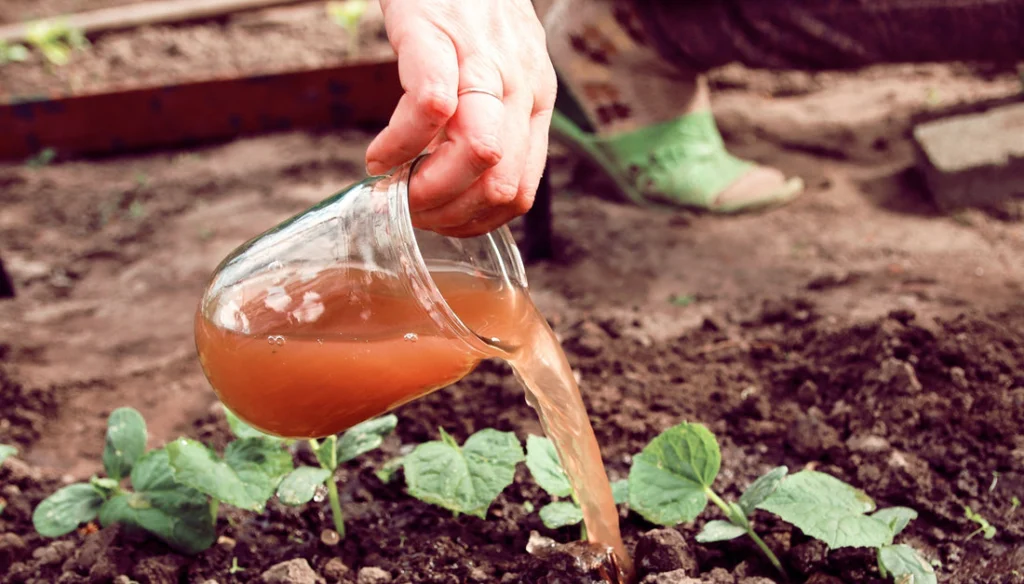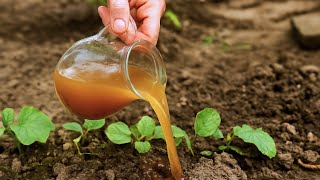Growing big, juicy tomatoes is the dream of every gardener. But did you know that a simple, all-natural fertilizer can make a world of difference? Passed down through generations, this homemade recipe combines yeast, sugar, and banana peels to nourish your tomato plants and enhance fruit production.
In this comprehensive guide, we’ll walk you through the preparation, application, and benefits of this natural fertilizer, ensuring your tomato plants thrive season after season.
🧪 Part 1: Understanding the Ingredients and Their Benefits
1.1 Yeast: The Microbial Powerhouse
Yeast is a living organism that, when introduced to the soil, activates beneficial microorganisms. These microbes break down organic matter, releasing essential nutrients like nitrogen, phosphorus, and potassium. This process enriches the soil, promoting healthy root development and robust plant growth.
1.2 Sugar: Fuel for Microbial Activity
Adding sugar to the mixture serves as a food source for the yeast and other beneficial microbes. The sugar accelerates the fermentation process, ensuring a potent and effective fertilizer. It’s important to note that the sugar content is minimal and primarily supports microbial activity rather than directly feeding the plants.
1.3 Banana Peels: A Nutrient-Rich Supplement
Banana peels are rich in potassium, magnesium, and calcium—nutrients that are vital for flowering and fruiting plants like tomatoes. Incorporating banana peels into your fertilizer mix provides these essential nutrients, promoting larger, juicier tomatoes. Additionally, using banana peels reduces food waste, making this fertilizer both eco-friendly and cost-effective.
🛠️ Part 2: Step-by-Step Guide to Preparing the Fertilizer
2.1 Ingredients You’ll Need
- 1 liter of warm water (not boiling)
- 1 tablespoon of dry baker’s yeast (or 20g of fresh yeast)
- 1 tablespoon of sugar
- 1 ripe banana peel (optional but beneficial)
2.2 Preparation Instructions
- Dissolve the Sugar: In a container, dissolve the sugar in the warm water, stirring until fully dissolved.
- Add the Yeast: Sprinkle the yeast into the sugar-water mixture, stirring gently to combine.
- Fermentation: Cover the container and let the mixture sit in a warm place for 2 hours. This allows the yeast to activate and begin the fermentation process.
- Prepare the Banana Peel: While the mixture is fermenting, chop the banana peel into small pieces.
- Combine: After 2 hours, add the chopped banana peel to the mixture, stirring well.
- Dilution: Before application, dilute the mixture with 5 liters of water to prevent over-fertilization.
🌱 Part 3: Application Tips for Maximum Effectiveness

- Frequency: Apply the fertilizer every 15 days during the growing season.
- Timing: Water your tomato plants in the morning or late afternoon to avoid the midday heat, which can cause rapid evaporation.
- Application Method: Pour the diluted fertilizer directly at the base of the plant, avoiding contact with the leaves to prevent potential fungal growth.
✅ Part 4: Why This Fertilizer Works
This homemade fertilizer combines the benefits of yeast fermentation with the nutrient-rich properties of banana peels. The yeast activates beneficial soil microbes, enhancing nutrient availability. The sugar accelerates fermentation, ensuring a potent mixture. The banana peel provides essential nutrients like potassium and magnesium, promoting healthy plant growth and fruit production.
⚠️ Part 5: Common Mistakes to Avoid
- Using Boiling Water: Boiling water can kill the yeast, rendering the fertilizer ineffective. Always use warm water.
- Over-Fertilization: Applying the fertilizer more frequently than recommended can lead to nutrient imbalances. Stick to the suggested schedule.
- Ignoring Dilution: Applying the undiluted mixture can harm your plants due to its high nutrient concentration. Always dilute before use.
🌿 Part 6: Additional Tips for Thriving Tomato Plants
- Soil Preparation: Before planting, amend the soil with compost to ensure a nutrient-rich environment.
- Mulching: Apply a layer of mulch around the base of the plants to retain moisture and regulate soil temperature.
- Pruning: Regularly prune dead or yellowing leaves to improve air circulation and reduce disease risk.
- Pest Management: Monitor plants for signs of pests and take appropriate action promptly.
🧰 Tools and Materials Checklist 🧪
- Measuring spoons
- Container for mixing
- Watering can
- Sharp knife for chopping banana peel
- Gloves (optional)
❓ Frequently Asked Questions (FAQs)
Q1: Can I store the leftover fertilizer for later use?
A1: It’s best to prepare fresh batches as needed. The mixture is most effective within 24 hours of preparation.
Q2: Can I use this fertilizer for other plants?
A2: Yes, this fertilizer is suitable for other fruiting plants like peppers and cucumbers.
Q3: Is it safe to use this fertilizer on indoor plants?
A3: While it’s safe, ensure proper ventilation when applying indoors to avoid any strong odors.
Q4: Can I use other fruit peels instead of banana peels?
A4: Banana peels are rich in potassium, making them ideal. Other fruit peels may not provide the same benefits.
Q5: Will this fertilizer attract pests?
A5: If applied correctly and not overused, this fertilizer shouldn’t attract pests. Always follow the recommended application guidelines.
🌟 Conclusion: Nurture Your Tomato Plants Naturally
By incorporating this homemade fertilizer into your gardening routine, you provide your tomato plants with the essential nutrients they need to thrive. This natural, cost-effective solution not only enhances plant growth but also promotes sustainable gardening practices. Happy gardening, and may your tomato harvest be abundant!
If you found this guide helpful, please share it with fellow gardening enthusiasts and leave a comment below with your experiences or questions!
Sources


411469 491504Hey There. I discovered your weblog using msn. That is a very smartly written post. I will make positive to bookmark it and come back to read much more of your helpful info. Thanks for the post. I will surely return. 111501
So kann man sich sicher sein, dass man eine sichere und innovative Glücksspiele-Erfahrung
machen kann, wenn man bei uns spielt. So kann
jeder Spieler einige Games entdecken, die perfekt zu den eigenen Vorstellungen passen und es
gibt immer wieder neue Spiele zu finden. Die mobile Version passt
sich instantly an die Bildschirmgröße Ihres
Geräts und bietet somit schnellem Zugriff auf alle Spiele und Funktionen – rund um die Uhr und
überall. Der Bonus reicht von 50 bis 135 %
und als weitere Leckerbissen gibt es 25 bis 100 Freispiele.
Bei einer Einzahlung vom Mindestbetrag 100€ gilt zusätzlich 100% Bonus bis 3.000€ + 100
Freispiele.
Wie Sie sich den 800€ Willkommensbonus und bis zu 200 Free Spins sichern können, verraten wir
Ihnen nun in unseren Hit’n’Spin Casino Erfahrungen. Dann finden Sie diesen auf der
Seite der Aktionen – dort, wo der jeweilige Bonus beschrieben ist.
Er beschert Bonusgeld und Freispiele. Der Willkommensbonus ist der
bekannteste Bonus. Nun wissen Sie über die Vielfalt der Casinoboni
bei Hit’n’Spin Bescheid.
Im hitnspin casino erleben Sie Baccarat in seiner elegantesten Form.
Im hitnspin casino erwartet Sie eine beeindruckende Vielfalt an Blackjack-Varianten für jeden Spielertyp.
Das Roulette-Angebot im hitnspin online casino begeistert durch seine außergewöhnliche
Vielfalt. Von klassischem Blackjack bis hin zu spannenden Pokervarianten bietet die Plattform
eine vielfältige Auswahl an Brettspielen für jeden Geschmack.
References:
https://online-spielhallen.de/posido-casino-deutschland-ein-umfassender-testbericht-fur-spieler/
Zum anderen soll die Bekämpfung illegaler Glücksspielanbieter
erfolgen, um ein sicheres und reguliertes Glücksspielumfeld zu schaffen. Die Betreiber müssen bestimmte
Auflagen erfüllen, um eine deutsche Casino-Lizenz zu erhalten. Ziel der
Legalisierung war es, den Spielerschutz zu verbessern, illegale
Glücksspielanbieter zu bekämpfen und die Spielsuchtprävention zu stärken.
Als einziges unabhängiges Portal, ähnlich wie Stiftung Warentest, und Computer Bild
haben wir alle legalen deutschen Online Casinos umfassend
getestet. Die beliebtesten Spiele in deutschen Online Casinos sind vor allem Spielautomaten wie
‘Book of Ra’, ‘Lucky Lady’s Charm’ und ‘Ramses
Book’. In den besten Online Casinos findest du zahlreiche Bonusangebote wie Willkommensboni, Freispiele
und Cashback-Optionen. Mit den richtigen Tipps und Strategien können Spieler ihre Chancen maximieren und verantwortungsvoll spielen. In deutschen Online Casinos gibt es eine Vielzahl von Bonusangeboten und
Aktionen, die darauf abzielen, die Spieler zu gewinnen und zu fördern.
Wir hoffen, dass dieser Guide Ihnen hilft, das perfekte
Online Casino für sich zu finden und ein sicheres und
unterhaltsames Spielerlebnis zu genießen. Ein umfassender FAQ-Bereich hilft Spielern, schnell Antworten auf
ihre Fragen zu finden und verbessert das gesamte Spielerlebnis.
Deutscher Support ist wichtig, um sprachliche Barrieren zu
vermeiden und die Kommunikation für deutsche Spieler zu erleichtern. Ein guter Kundenservice sollte 24/7 verfügbar sein, freundliche und qualitativ
hochwertige Antworten bieten und umfassende FAQ-Bereiche haben.
Die browserbasierten Versionen passen sich automatisch an die Bildschirmgröße des Geräts
an, um ein optimales Spielerlebnis zu bieten. LeoVegas
bietet eine mobil optimierte, preisgekrönte App, die das Spielen unterwegs zum Vergnügen macht.
References:
https://online-spielhallen.de/dein-weg-zum-my-empire-casino-bonuscode-alles-was-du-wissen-musst/